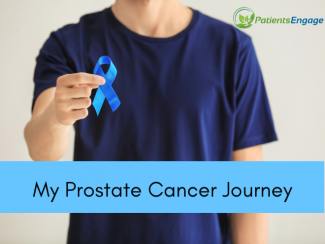
A routine annual screening led to a diagnosis of an aggressive form of Stage 3 prostate cancer. A prostate cancer survivor shares his experience from diagnosis to treatment and now a 5-year survival.
Background
I was diagnosed with prostate cancer when I had just turned 50.
A routine annual medical checkup revealed a PSA (prostate specific antigen) reading of 9 (normal range being 0-4). I was otherwise quite healthy, with no other red flags in my annual medical, and led a very active lifestyle with regular gym/sports, yoga. My diet was usually very healthy, primarily vegetarian with an occasional fish or chicken (no red meat). A non- smoker all my life, and an occasional glass or two of wine on social occasions.
Symptoms : There were absolutely no symptoms
Initial reaction : Was of complete disbelief and shock – how can this happen to me when I have such a healthy lifestyle and with no warning?
Diagnosis/Course of action
The PSA reading was followed by further tests and biopsy in India (I had gone there on a personal trip) to confirm the diagnosis of prostate cancer. During this process I went through several days of lost sleep and stress trying to come to grips with the situation. The cancer specialist in India was quite clear that prostate surgery was required (prostatectomy) and suggested doing the surgery in Singapore using robotic surgery. According to him, Singapore had the latest Da Vinci robot with experienced surgeons to perform the surgery.
I was referred a surgeon by a friend in Singapore who did a few other tests to confirm robotic surgery as the best course of action. There continued to be no symptoms during this period. Surgery was done about 3 weeks after the initial diagnosis, the procedure lasting about 2-2.5 hours. I stayed in hospital for 2 days after the surgery and stayed home on leave for another 4-5 days
Post Surgery : The lab report after the surgery revealed that it was stage 3 prostate cancer with a Gleason score of 9. The surgeon recommended hormone therapy treatment for a period of two years – this involved daily oral meds for a few months and then an injection in the stomach every 3 months. I started on this immediately. A couple of other oncologists I had consulted recommended going in for Radiation therapy after the surgery to counter the ‘aggressive ‘ cancer. I was quite reluctant with this suggestion, the surgeon also disagreed with this saying this was unnecessarily throwing the kitchen sink at the problem when it was not warranted. This period was quite uncertain with the various alternatives constantly weighing on my mind, before I decided to just do the hormone therapy and avoid radiation
Side effects : The cancer had resulted in a depletion of Bone mineral density (BMD) as well as Vitamin D levels, hence I took calcium/Vitamin supplements daily. the surgeon recommended starting on walks as soon as possible, increasing the speed and distance as the body could handle.
What I did find out was that there is an increased risk of inguinal hernia after robotic prostatectomy. So it is important to avoid lifting of heavy weights or bags as the pelvic area is quite weak after the procedure.
Post surgery Work Life : I was back at work within a week of the surgery, having decided not to let my company know about my diagnosis, in case it affected my career. Luckily, the corporate insurance company deals directly with the employee in such cases without needing to go through the company HR. I had no problems back at work , and was able to undertake business travel within a couple of months of the surgery
Lifestyle changes : The two years of hormone therapy passed by without incident. I continued my regular walks, yoga , and tried to cut out as much processed foods as possible from my diet. Over time, I also incorporated climbing of stairs and weight training into my routine to build bone strength.
Disclosure: Being a fairly private person, I decided to inform only my immediate family of my diagnosis to avoid unnecessary discussions on the subject with other relatives or friends
Current status : It is now more than 5 years since the diagnosis, with the PSA reading clear all through. The surgeon has changed the PSA testing frequency to every 9 months from monthly/quarterly
Lessons learned : I believe annual medical check is imperative once you cross 40 to enable detection of problems before they become insurmountable. Multiple treatment suggestions can be confusing, it helps to trust your medical team.
Anonymised on request






